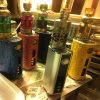I have been very curious about this phenomenon of overstated output power in vape mods since the Sigelei 213 blunder. I documented myself about the state of retail in the Far East region, and from what I understand the customers are driven, for their purchases, by two factors which have been tamed here since a long time.
The two factors are: "Impulse buy" and "Mine is bigger" ; the first is of personal importance, the second is socially relevant.
Doesn't matter if the mod can truly deliver the stated 213 Watts (the Sigelei 213 delivers 140 W at max), the social push has an overwhelming importance there, and the attitude is well exploited by the vape manufacturers and sellers.
BTW. The only two-cells mod capable of delivering 200 W are the Yihi Q class and G class, when I use the correct 1500 mAh battery. All the other "budget" mods use are limited by the wrong ferrite core in the switcher circuitry, and by an underspecified output MOSFET pair.
I agree that the most relevant argument here is the adherence to the specs, not the "excessive" power. As others in this thread, I don't agree to additional regulations, it can only be bad. It would be enough that manufacturers would follow existing safety regulation, by inserting a fuse in series with the battery: while it is mandatory in nearly all regional safety regulations (CE, FCC, etc.) only an handful of mod brands (Innokin, Yihi, etc al.) provide a fuse (or a fuse resistor); the rest of the mod makers being happy to demonstrate how the theory of the catastrophies can develop.
Another sore point, mentioned by a poster in this thread. The majority of mods shows voltage and power on their display as they read the values from a look-up table stored in the ROM, therefore when the output circuit fails to provide the 200 W displayed because the transformer core is saturated, the user fails to notice it, too.
Real-time measurements are present in the top three, and they all reach the advertised power, too.
Last thing I like to mention here, it is the role of reviewers. Vape gear is not beta-tested, there is a despicable lack of literature both for servicing and instructional, and the turnover is frankly excessive.
Therefore reviewers play a role unseen for other manufact (how many hairdryers reviews on YouTube?) and manufacturers give them great importance.
There are too many jewels of the type: "I cannot explain why the 2000 mah battery in the J150 lasts so much longer than the battery of the J80, which also is 2000 mah".
This guy doesn't know the very basics of electricity... It also explains why eLeaf did something blatantly incorrect, by declaring as 5000 mah the 1650 mah 3s LiPo battery in their Istick 200 QC... to protect themselves from this type of reviewers.
They damage the vape as whole, we should down vote ignorant reviews, as it is the only possible improvement we can provide.
Reviews cannot be complacent, otherwise... Otherwise we have the majority of 200 W mods not giving the stated power (the 200 Qc give 175 W max, BTW), and I do not even start to talk about temperature control.
Complacent reviewers are a problem to vaping, more than what you may think.
I wasn't expecting to write a wall of text, but I am fed up beyond recovery by the amount of misrepresentation in the vape world; it is of little consolation to see I'm not alone.
EDIT: Spaced the paragraphs somewhat.



